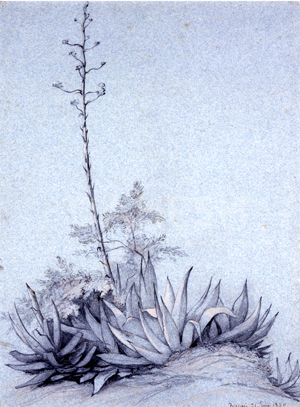Charles Damour (French, 1813–1901?)
Flowering Agave, 1836
Graphite and body color with pen and black ink on blue paper, 12 x 9 in.
Annotated and dated, lower right: Biscari 21 Juin 1836
Gift of Decourcy E. McIntosh
2003.26

In June 1836 Damour toured Sicily. In the small town of Biscari (now called Acate), he drew this delicate landscape, which centers on a flowering agave—a plant native to North America that became popular in European ornamental gardens in the 19th century. Damour took care to show this agave as it begins to bloom, an efflorescence that peaks just before the plant dies. Plant species from the Americas and Asia were introduced to Europe in the 16th century, prompting interest in exotic flora. Artists such as Albrecht Dürer focused their skilled technique on individual examples—both native and imported—and began depicting plant life in minute detail. In the 18th century the need for even more accurate illustrations arose as botanical studies, such as Linnaeus’ Species Plantarum (1753), were published with greater frequency. By the 19th century the ability to meticulously represent plants had become essential to both botanist and artist alike.


